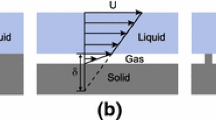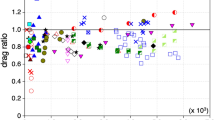Abstract
The drag-reducing property of a superhydrophobic surface is investigated along with its mechanism. A superhydrophobic surface with micro–nanotextures is fabricated and tested using SEM and contact angle measurement. Velocity distributions in the turbulent boundary layer with a superhydrophobic surface and a smooth surface are measured by particle image velocimetry at Re θ = 810, 990, and 1220. An upward lift effect on the velocity profile caused by the rugged air layer on the superhydrophobic surface is observed, which indicates drag reduction. Estimated by the wall shear stress, a drag reduction of 10.1, 20.7, and 24.1 % is observed for Re θ equal to 810, 990, and 1220, respectively. The drag reduction is caused mainly by slip on the interface and modifications in the turbulent structures, and the latter plays a more important role as Re θ increases. Suppressions are observed in turbulence intensities, and reductions in the total Reynolds shear stress T +turb are 2.5, 18.5, and 23.1 % for Re θ = 810, 990, and 1220, respectively. Vortex fields above the superhydrophobic and smooth surfaces at Re θ = 990 are investigated. Vortexes are weakened and lifted upward by the superhydrophobic surface, and the position of the maximum swirling strength is lifted 0.17δ (δ is the boundary layer thickness) upward in the wall-normal direction. This modification in turbulence structures contributes significantly to the drag reduction in the turbulent boundary layer flow.














Similar content being viewed by others
References
Adrian RJ (2007) Hairpin vortex organization in wall turbulence. Phys Fluids 19(4):041301
Adrian RJ, Christensen KT, Liu ZC (2000a) Analysis and interpretation of instantaneous turbulent velocity fields. Exp Fluids 29(3):275–290
Adrian RJ, Meinhart CD, Tomkins CD (2000b) Vortex organization in the outer region of the turbulent boundary layer. J Fluid Mech 422:1–54
Aljallis E, Sarshar MA, Datla R, Sikka V, Jones A, Choi CH (2013) Experimental study of skin friction drag reduction on superhydrophobic flat plates in high Reynolds number boundary layer flow. Phys Fluids 25(2):025103
Bernard PS, Thomas JM, Handler RA (1993) Vortex dynamics and the production of Reynolds stress. J Fluid Mech 253:385–419
Choi CH, Kim CJ (2006) Large slip of aqueous liquid flow over a nanoengineered superhydrophobic surface. Phys Rev Lett 96(6):066001
Choi CH, Ulmanella U, Kim J, Ho CM, Kim CJ (2006) Effective slip and friction reduction in nanograted superhydrophobic microchannels. Phys Fluids 18:087105
Christensen KT, Adrian RJ (2001) Statistical evidence of hairpin vortex packets in wall turbulence. J Fluid Mech 431:433–443
Daniello RJ, Waterhouse NE, Rothstein JP (2009) Drag reduction in turbulent flows over superhydrophobic surfaces. Phys Fluids 21:085103
Elsinga GE, Adrian RJ, Van Oudheusden BW, Scarano F (2010) Three-dimensional vortex organization in a high-Reynolds-number supersonic turbulent boundary layer. J Fluid Mech 644:35–60
Feng L, Li SH, Li YS, Li HJ, Zhang LJ, Zhai J, Song YL, Liu BQ, Jiang L, Zhu DB (2002) Super-hydrophobic surfaces: from natural to artificial. Adv Mater 14:1857–1860
Fukagata K, Iwamoto K, Kasagi N (2002) Contribution of Reynolds stress distribution to the skin friction in wall-bounded flows. Phys Fluids 14(11):L73–L76
Ganapathisubramani B, Longmire EK, Marusic I (2003) Characteristics of vortex packets in turbulent boundary layers. J Fluid Mech 478:35–46
Gogte S, Vorobieff P, Truesdell R, Mammoli A, Van Swol F, Shah P, Brinker CJ (2005) Effective slip on textured superhydrophobic surfaces. Phys Fluids 17(5):51701
Jiménez J (2004) Turbulent flows over rough walls. Anuu Rev Fluid Mech 36:173–196
Joseph P, Cottin-Bizonne C, Benoit JM, Ybert C, Journet C, Tabeling P, Bocquet L (2006) Slippage of water past superhydrophobic carbon nanotube forests in microchannels. Phys Rev Lett 97(15):156104
Kida S, Tanaka M (1992) Reynolds stress and vortical structure in a uniformly sheared turbulence. J Phys Soc Jpn 61(12):4400–4417
Kolář V (2007) Vortex identification: new requirements and limitations. Int J Heat Fluid Flow 28(4):638–652
Krupenkin TN, Taylor JA, Schneider TM et al (2004) From rolling ball to complete wetting: the dynamic turning of liquids on nanostructured surfaces. Langmuir 20(10):3824–3827
Lee C, Choi CH (2008) Structured surfaces for a giant liquid slip. Phys Rev Lett 101(6):064501
Lu S, Yao ZH, Hao PF, Fu CS (2010) Drag reduction in ultrahydrophobic channels with micro- nanostructured surfaces. Sci China Phys Mech Astron 53(7):1298–1305
Martell MB, Rothstein JP, Perot JB (2010) An analysis of superhydrophobic turbulent drag reduction mechanisms using direct numerical simulation. Phys Fluids 22:065102
Min T, Kim J (2004) Effects of hydrophobic surface on skin-friction drag. Phys Fluids 16(7):L55–L58
Nishino T, Meguro M, Nakamae K, Matsushita M, Ueda Y (1999) The lowest surface free energy based on –CF3 alignment. Langmuir 15:4321–4323
Onda T, Shibuichi S, Satoh N, Tsujii K (1996) Super-water-repellent fractal surfaces. Langmuir 12:2125–2127
Öner D, McCarthy TJ (2000) Ultrahydrophobic surfaces. Effects of topography length scales on wettability. Langmuir 16:7777–7782
Ou J, Rothstein JP (2005) Direct velocity measurements of the flow past drag-reducing ultrahydrophobic surfaces. Phys Fluids 17:103606
Ou J, Perot B, Rothstein JP (2004) Laminar drag reduction in microchannels using ultrahydrophobic surfaces. Phys Fluids 16(12):4635–4643
Park H, Park H, Kim J (2013) A numerical study of the effects of superhydrophobic surface on skin-friction drag in turbulent channel flow. Phys Fluids 25:110815
Park H, Sun G, Kim CJ (2014) Superhydrophobic turbulent drag reduction as a function of surface grating parameters. J Fluid Mech 747:722–734
Patankar NA (2003) On the modeling of hydrophobic contact angles on rough surfaces. Langmuir 19:1249–1253
Rothstein JP (2010) Slip on superhydrophobic surfaces. Annu Rev Fluid Mech 42:89–109
Shiu JY, Kuo CW, Chen P, Mou CY (2004) Fabrication of tunable superhydrophobic surfaces by nanosphere lithography. Chem Mater 16:561–564
Spalart PR (1988) Direct simulation of a turbulent boundary layer up to R θ = 1410. J Fluid Mech 187:61–98
Tomkins CD, Adrian RJ (2003) Spanwise structure and scale growth in turbulent boundary layers. J Fluid Mech 490:37–74
Truesdell R, Mammoli A, Vorobieff P, van Swol F, Brinker CJ (2006) Drag reduction on a patterned superhydrophobic surface. Phys Rev Lett 97(4):044504
Westerweel J, Elsinga GE, Adrian RJ (2013) Particle image velocimetry for complex and turbulent flows. Annu Rev Fluid Mech 45:409–436
Woolford B, Prince J, Maynes D, Webb BW (2009) Particle image velocimetry characterization of turbulent channel flow with rib patterned superhydrophobic walls. Phys Fluids 21:085106
Zhang JX, Yao ZH, Lu S, Hao PF, Fu CS (2013) Drag reduction in turbulent flows over superhydrophobic surfaces with micro-nano textures. In: The 14th Asia congress of fluid mechanics, Hanoi and Halong, Vietnam, 0777–0782
Zhou J, Adrian RJ, Balachandar S, Kendall TM (1999) Mechanisms for generating coherent packets of hairpin vortices in channel flow. J Fluid Mech 387:353–396
Acknowledgments
This work is supported by Grants-in-Aid from the National Natural Science Foundation of China (No. 11272176).
Author information
Authors and Affiliations
Corresponding author
Electronic supplementary material
Below is the link to the electronic supplementary material.
Rights and permissions
About this article
Cite this article
Zhang, J., Tian, H., Yao, Z. et al. Mechanisms of drag reduction of superhydrophobic surfaces in a turbulent boundary layer flow. Exp Fluids 56, 179 (2015). https://doi.org/10.1007/s00348-015-2047-y
Received:
Revised:
Accepted:
Published:
DOI: https://doi.org/10.1007/s00348-015-2047-y




